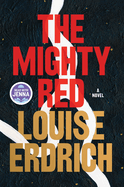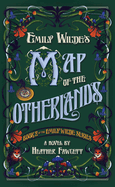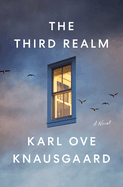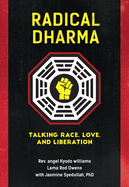 The Mighty Red
The Mighty Red
Louise Erdrich
Harper
In Argus, North Dakota, a collection of people revolve around a fraught wedding.
Gary Geist, a terrified young man set to inherit two farms, is desperate to marry Kismet Poe, an impulsive, lapsed Goth who can’t read her future but seems to resolve his.
Hugo, a gentle red-haired, home-schooled giant, is also in love with Kismet. He’s determined to steal her and is eager to be a home wrecker.
Kismet’s mother, Crystal, hauls sugar beets for Gary’s family, and on her nightly runs, tunes into the darkness of late-night radio, sees visions of guardian angels, and worries for the future, her daughter’s and her own.
Human time, deep time, Red River time, the half-life of herbicides and pesticides, and the elegance of time represented in fracking core samples from unimaginable depths, is set against the speed of climate change, the depletion of natural resources, and the sudden economic meltdown of 2008-2009. How much does a dress cost? A used car? A package of cinnamon rolls? Can you see the shape of your soul in the everchanging clouds? Your personal salvation in the giant expanse of sky? These are the questions the people of the Red River Valley of the North wrestle with every day.
The Mighty Red is a novel of tender humor, disturbance, and hallucinatory mourning. It is about on-the-job pains and immeasurable satisfactions, a turbulent landscape, and eating the native weeds growing in your backyard. It is about ordinary people who dream, grow up, fall in love, struggle, endure tragedy, carry bitter secrets; men and women both complicated and contradictory, flawed and decent, lonely and hopeful. It is about a starkly beautiful prairie community whose members must cope with devastating consequences as powerful forces upend them. As with every book this great modern master writes, The Mighty Red is about our tattered bond with the earth, and about love in all of its absurdity and splendor.
A new novel by Louise Erdrich is a major literary event; gorgeous and heartrending, The Mighty Red is a triumph.
 Emily Wilde’s Map of the Otherlands
Emily Wilde’s Map of the Otherlands
Heather Fawcett
Del Rey Books
Emily Wilde is a genius scholar of faerie folklore who just wrote the world’s first comprehensive encyclopaedia of faeries. She’s learned many of the secrets of the Hidden Ones on her adventures . . . and also from her fellow scholar and former rival Wendell Bambleby.
Because Bambleby is more than infuriatingly charming. He’s an exiled faerie king on the run from his murderous mother and in search of a door back to his realm. And despite Emily’s feelings for Bambleby, she’s not ready to accept his proposal of marriage: Loving one of the Fair Folk comes with secrets and dangers.
She also has a new project to focus on: a map of the realms of faerie. While she is preparing her research, Bambleby lands her in trouble yet again, when assassins sent by his mother invade Cambridge. Now Bambleby and Emily are on another adventure, this time to the picturesque Austrian Alps, where Emily believes they may find the door to Bambleby’s realm and the key to freeing him from his family’s dark plans.
But with new relationships for the prickly Emily to navigate and dangerous Folk lurking in every forest and hollow, Emily must unravel the mysterious workings of faerie doors and of her own heart.
 Seeing Further
Seeing Further
Esther Kinsky
New York Review Books
In this autobiographical novel by a leading German author and translator, the narrator attempts to revive a run-down Hungarian movie theater–an unpromising endeavor that soon leads into a consideration of the building’s history and an homage to the power of the cinema, imperiled as it may be in our time.
While travelling through the Great Alföld, the vast plain in southeastern Hungary, the narrator of Seeing Further stops in an all but vacant town near the Romanian border. There she happens upon a dilapidated movie theater. Once the heart of the village, it has been boarded up for years. Entranced, she soon finds herself embarking on the colossal task of renovating it in order to preserve the cinematic experience.
Seeing Further illuminates the cinema’s former role as a communal space for collective imagining. For Esther Kinsky and her narrator, it remains a place of wonder, a dark room that unfurls a vastness not beholden to the ordinary rules of time and space. Seeing Further is an homage to cinema in words and pictures.
 The Third Realm
The Third Realm
Karl Ove Knausgaard
Penguin Press
For several days, a strange and bright new star in the sky above Norway has sown an unyielding sense of foreboding, of agitation, and of fear. Tove, a painter on holiday with her family, has spiraled into a psychosis that stirs her into a flurry of unbridled creativity. Geir, a policeman who has been investigating a grisly triple murder, comes to a sinister revelation he must keep to himself. Nineteen-year-old Line falls in love with the lead singer of a metal band and is lured into a secret and frightening world.
But most bewildering, and disquieting, is the discovery made by Syvert, an undertaker: since the star has appeared, no one has died.
In The Third Realm, Karl Ove Knausgaard returns to the spellbinding world of The Morning Star and The Wolves of Eternity, as a cast of new and familiar characters continue to reckon with the meaning of this star. What is haunting them, and why?
As supernatural forces collide with the mundanities of everyday, and the threshold between life and death becomes diffuse, people are forced to live their lives as before while the world around them slowly changes in inexplicable ways. Piercing through human existence into the bestial and phantasmagorical, Knausgaard flings opens the gates to our most distressing neuroses and forces us to ask: What happens if the dark forces in the world are set free?
 The Barn: The Secret History of a Murder in Mississippi
The Barn: The Secret History of a Murder in Mississippi
Wright Thompson
Penguin Press
Wright Thompson’s family farm in Mississippi is 23 miles from the site of one of the most notorious and consequential killings in American history, yet he had to leave the state for college before he learned the first thing about it. To this day, fundamental truths about the crime are widely unknown, including where it took place and how many people were involved. This is no accident: the cover-up began at once, and it is ongoing.
In August 1955, two men, Roy Bryant and J.W. Milam, were charged with the torture and murder of the 14-year-old Emmett Till in Money, Mississippi. After their inevitable acquittal in a mockery of justice, they gave a false confession to a journalist, which was misleading about where the long night of hell took place and who was involved. In fact, Wright Thompson reveals, at least eight people can be placed at the scene, which was inside the barn of one of the killers, on a plot of land within the six-square-mile grid whose official name is Township 22 North, Range 4 West, Section 2, West Half, fabled in the Delta of myth as the birthplace of the blues on nearby Dockery Plantation.
Even in the context of the racist caste regime of the time, the four-hour torture and murder of a Black boy barely in his teens for whistling at a young white woman was acutely depraved; Till’s mother Mamie Till-Mobley’s decision to keep the casket open seared the crime indelibly into American consciousness. Wright Thompson has a deep understanding of this story–the world of the families of both Emmett Till and his killers, and all the forces that aligned to place them together on that spot on the map. As he shows, the full horror of the crime was its inevitability, and how much about it we still need to understand. Ultimately this is a story about property, and money, and power, and white supremacy. It implicates all of us. In The Barn, Thompson brings to life the small group of dedicated people who have been engaged in the hard, fearful business of bringing the truth to light. Putting the killing floor of the barn on the map of Township 22 North, Range 4 West, Section 2, West Half, and the Delta, and America, is a way of mapping the road this country must travel if we are to heal our oldest, deepest wound.
 Radical Dharma: Talking Race, Love, and Liberation
Radical Dharma: Talking Race, Love, and Liberation
Rev. angel Kyodo williams, & Lama Rod Owens, with Jasmine Syedullah, PhD
North Atlantic Books
Igniting a long-overdue dialogue about how the legacy of racial injustice and white supremacy plays out in society at large and Buddhist communities in particular, this urgent call to action outlines a new dharma that takes into account the ways that racism and privilege prevent our collective awakening. The authors traveled around the country to spark an open conversation that brings together the Black prophetic tradition and the wisdom of the Dharma. Bridging the world of spirit and activism, they urge a compassionate response to the systemic, state-sanctioned violence and oppression that has persisted against black people since the slave era. With national attention focused on the recent killings of unarmed black citizens and the response of the Black-centered liberation groups such as Black Lives Matter, Radical Dharma demonstrates how social transformation and personal, spiritual liberation must be articulated and inextricably linked.
Rev. angel Kyodo williams, Lama Rod Owens, and Jasmine Syedullah represent a new voice in American Buddhism. Offering their own histories and experiences as illustrations of the types of challenges facing dharma practitioners and teachers who are different from those of the past five decades, they ask how teachings that transcend color, class, and caste are hindered by discrimination and the dynamics of power, shame, and ignorance. Their illuminating argument goes beyond a demand for the equality and inclusion of diverse populations to advancing a new dharma that deconstructs rather than amplifies systems of suffering and prepares us to weigh the shortcomings not only of our own minds but also of our communities. They forge a path toward reconciliation and self-liberation that rests on radical honesty, a common ground where we can drop our need for perfection and propriety and speak as souls. In a society where profit rules, people’s value is determined by the color of their skin, and many voices–including queer voices–are silenced, Radical Dharma recasts the concepts of engaged spirituality, social transformation, inclusiveness, and healing.